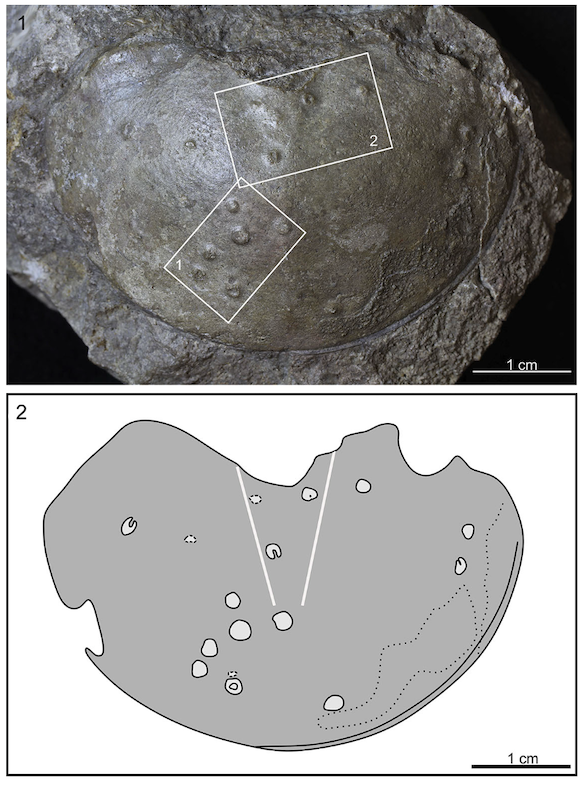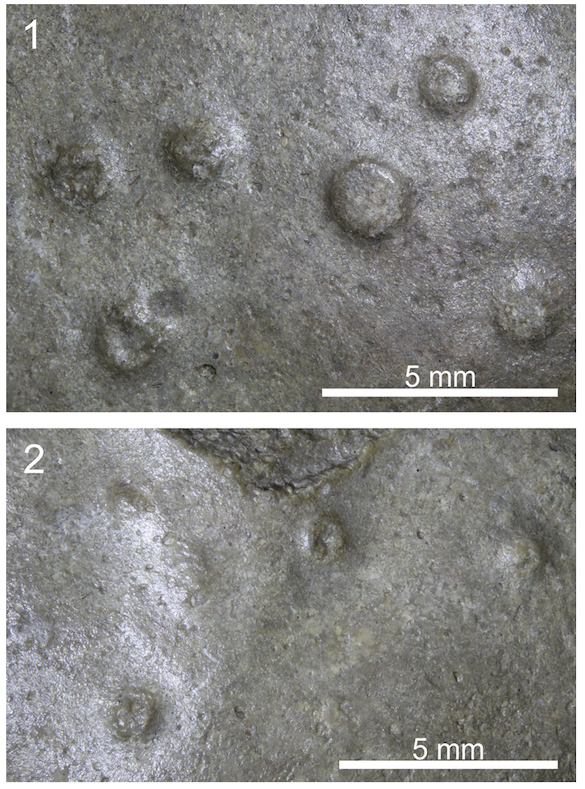A spotty Middle Ordovician trilobite from Estonia: A new paper describing an ancient parasitic infection
 One of the many reasons we need natural history museums is that they can curate large collections of specimens that can be examined for interesting features decades after they were bagged in the field. Recently my Estonian colleagues Olev Vinn and Ursula Toom searched through hundreds of museum specimens of the Middle Ordovician trilobite Illaenus for evidence of parasitism. They found one internal mold of the pygidium (“tail”) that had a constellation of pits, as if the poor creature had smallpox (which it most certainly did not!). It did have an infection of some kind, though — a rare find in the fossil record. The Estonians contacted me, Kenneth De Baets and Russell Bicknell, and the five of us put together a paper that appeared today as an open-access article in the Journal of Paleontology. Here I present the abstract and a couple of figures. This article is free to read at the journal link.
One of the many reasons we need natural history museums is that they can curate large collections of specimens that can be examined for interesting features decades after they were bagged in the field. Recently my Estonian colleagues Olev Vinn and Ursula Toom searched through hundreds of museum specimens of the Middle Ordovician trilobite Illaenus for evidence of parasitism. They found one internal mold of the pygidium (“tail”) that had a constellation of pits, as if the poor creature had smallpox (which it most certainly did not!). It did have an infection of some kind, though — a rare find in the fossil record. The Estonians contacted me, Kenneth De Baets and Russell Bicknell, and the five of us put together a paper that appeared today as an open-access article in the Journal of Paleontology. Here I present the abstract and a couple of figures. This article is free to read at the journal link.
Abstract
Evidence for parasites in the fossil record is rare. As such, any examples present insight into parasitism in deep time. Trilobites have often been used for documenting parasites in the Paleozoic. Here we examine an Illaenus sp. pygidium from the Middle Ordovician of Estonia that displays thirteen small structures with domical to crater-like shapes. These morphologies are consistent with circular depressions on the pygidium inner surface. We propose that these structures formed while the trilobite was alive and record an infestation located within soft tissue. The trace maker seems to have influenced pygidial mineralization and caused a pathological reaction. The symbiont may have been capable of bioerosion, excavating these depressions by dissolving the trilobite’s mineral tissues; however, this scenario is less likely considering comparisons with syndromes and pathologies known in modern arthropods. The parasitic organism may have fed on the trilobite’s tissues or utilized nutrients within the trilobite’s body for growth. These observations are consistent with a parasitic organism.
 Figure 1. Internal mold of Illaenus sp. pygidium with traces of parasitic infestation from
Figure 1. Internal mold of Illaenus sp. pygidium with traces of parasitic infestation from
Darriwilian of northern Estonia (GIT 437-107); (1) Complete specimens. Rectangle
1 shows location of detailed Fig. 2.1, and rectangle 2 shows location of detailed
Fig. 2.2. (2) Drawing of the pygidium.
 Figure 2. Internal mold of Illaenus sp. pygidium with traces of parasitic infestation from
Figure 2. Internal mold of Illaenus sp. pygidium with traces of parasitic infestation from
the Darriwilian of northern Estonia (GIT 437-107); (1) Detail view of traces; showing two
simple bumps and four crater-like structures, (2) Detail views of traces; showing two
simple bumps and two crater-like structures.
Reference:
Vinn O., Wilson, M.A., De Baets, K., Bicknell, R., and Toom, U. 2025. Parasitic infestation in a Middle Ordovician Illaenus (Trilobita). Journal of Paleontology, 1–6 https://doi.org/10.1017/jpa.2025.10190
Source: https://woostergeologists.scotblogs.wooster.edu/2025/11/26/a-spotty-middle-ordovician-trilobite-from-estonia-a-new-paper-describing-an-ancient-parasitic-infection/
Anyone can join.
Anyone can contribute.
Anyone can become informed about their world.
"United We Stand" Click Here To Create Your Personal Citizen Journalist Account Today, Be Sure To Invite Your Friends.
Before It’s News® is a community of individuals who report on what’s going on around them, from all around the world. Anyone can join. Anyone can contribute. Anyone can become informed about their world. "United We Stand" Click Here To Create Your Personal Citizen Journalist Account Today, Be Sure To Invite Your Friends.
LION'S MANE PRODUCT
Try Our Lion’s Mane WHOLE MIND Nootropic Blend 60 Capsules
Mushrooms are having a moment. One fabulous fungus in particular, lion’s mane, may help improve memory, depression and anxiety symptoms. They are also an excellent source of nutrients that show promise as a therapy for dementia, and other neurodegenerative diseases. If you’re living with anxiety or depression, you may be curious about all the therapy options out there — including the natural ones.Our Lion’s Mane WHOLE MIND Nootropic Blend has been formulated to utilize the potency of Lion’s mane but also include the benefits of four other Highly Beneficial Mushrooms. Synergistically, they work together to Build your health through improving cognitive function and immunity regardless of your age. Our Nootropic not only improves your Cognitive Function and Activates your Immune System, but it benefits growth of Essential Gut Flora, further enhancing your Vitality.
Our Formula includes: Lion’s Mane Mushrooms which Increase Brain Power through nerve growth, lessen anxiety, reduce depression, and improve concentration. Its an excellent adaptogen, promotes sleep and improves immunity. Shiitake Mushrooms which Fight cancer cells and infectious disease, boost the immune system, promotes brain function, and serves as a source of B vitamins. Maitake Mushrooms which regulate blood sugar levels of diabetics, reduce hypertension and boosts the immune system. Reishi Mushrooms which Fight inflammation, liver disease, fatigue, tumor growth and cancer. They Improve skin disorders and soothes digestive problems, stomach ulcers and leaky gut syndrome. Chaga Mushrooms which have anti-aging effects, boost immune function, improve stamina and athletic performance, even act as a natural aphrodisiac, fighting diabetes and improving liver function. Try Our Lion’s Mane WHOLE MIND Nootropic Blend 60 Capsules Today. Be 100% Satisfied or Receive a Full Money Back Guarantee. Order Yours Today by Following This Link.






